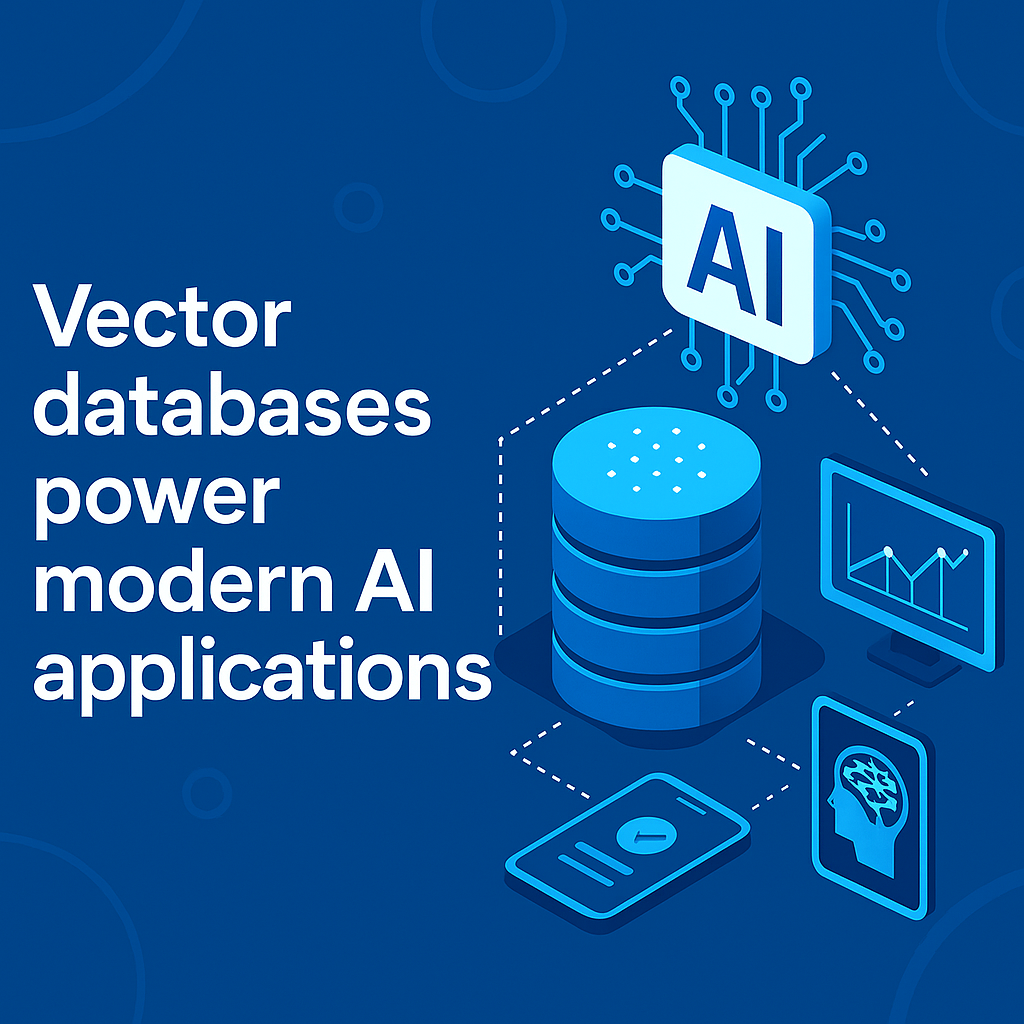In the era of AI and machine learning, traditional databases often fall short when handling complex data like text, images, and embeddings. This is where vector databases come in—a specialized type of database designed to store, index, and search high-dimensional vector data efficiently.

From powering recommendation systems to enabling semantic search in applications like ChatGPT, vector databases are becoming essential infrastructure for modern AI applications.
What Is a Vector Database?
A vector database is a database optimized for storing and querying vector embeddings—numerical representations of data (text, images, audio, etc.) generated by machine learning models.
Key Features:
- Efficient similarity search: Finds the most similar vectors using algorithms like Approximate Nearest Neighbor (ANN) search.
- Scalability: Handles millions or billions of vectors with low latency.
- Flexible indexing: Uses specialized structures like HNSW (Hierarchical Navigable Small World) or IVF (Inverted File Index) for fast retrieval.
How Do Vector Databases Work?
Data Embedding
Raw data (text, images) is converted into vectors using models like OpenAI's embeddings or BERT.
Vector Storage
The database indexes these vectors for efficient retrieval.
Querying
When a search is performed, the database finds the closest matching vectors using distance metrics (cosine similarity, Euclidean distance).
Why Use a Vector Database?
Traditional databases (SQL, NoSQL) struggle with:
- High-dimensional data (e.g., 768+ dimensions in embeddings)
- Fast similarity searches (exact searches are too slow)
- Real-time AI applications (recommendations, chatbots)
Advantages Over Traditional Databases
| Feature | Vector Database | Traditional Database |
|---|---|---|
| Query Type | Similarity search | Exact match |
| Performance | Optimized for ANN | Optimized for CRUD |
| Use Case | AI/ML applications | Structured data |
Top Use Cases for Vector Databases
1. Semantic Search
- Search engines that understand meaning (e.g., Google's MUM, ChatGPT plugins).
- Finds relevant results even if keywords don't match exactly.
2. Recommendation Systems
- "Users who liked X also liked Y" based on vector similarity.
- Used by Netflix, Amazon, and Spotify.
3. Image & Video Search
- Reverse image search (Google Lens, Pinterest).
- Content moderation (finding similar banned images).
4. Anomaly Detection
- Detects fraud, network intrusions, or manufacturing defects by comparing vectors against normal patterns.
5. AI-Powered Chatbots & LLMs
- Retrieval-Augmented Generation (RAG) in ChatGPT uses vector search for real-time knowledge retrieval.
How Vector Databases Work Internally
1. Indexing Methods
HNSW (Hierarchical Navigable Small World)
A graph-based method for fast approximate search.
IVF (Inverted File Index)
Clusters vectors into "buckets" for faster retrieval.
2. Distance Metrics
Cosine Similarity
Measures angle between vectors (best for text).
Euclidean Distance
Straight-line distance between points (good for images).
3. Query Execution
Query Embedding
A query embedding is generated.
Vector Search
The database searches indexed vectors for nearest matches.
Result Ranking
Results are ranked by similarity score.
Popular Vector Database Solutions
| Database | Key Features | Best For |
|---|---|---|
| Pinecone | Fully managed, high performance | Production-grade AI apps |
| Weaviate | Open-source, hybrid search | Developers needing flexibility |
| Milvus | Scalable, open-source | Large-scale deployments |
| Qdrant | Fast, Rust-based | Low-latency applications |
| Chroma | Lightweight, easy to use | Prototyping & small projects |
Best Practices for Using Vector Databases
Choose the Right Embedding Model
OpenAI's text-embedding-3-large for text, CLIP for images.
Optimize Indexing
Use HNSW for high recall, IVF for speed. Adjust parameters like efConstruction (HNSW) for better performance.
Filtering & Hybrid Search
Combine vector search with metadata filters (e.g., "find similar products under $50").
Monitor Performance
Track query latency, recall rate, and scalability.
Future of Vector Databases
- Multi-modal search (combining text, image, and audio vectors)
- Real-time updates (streaming data support)
- Integration with LLMs (better RAG pipelines)
Conclusion
Vector databases are revolutionizing how we search and analyze unstructured data. Whether you're building a recommendation engine, a semantic search tool, or an AI chatbot, understanding vector databases is crucial.
Next Steps:
- Experiment with open-source options like Weaviate or Chroma.
- Try a managed service like Pinecone for production workloads.
- Explore hybrid search (keyword + vector) for better results.